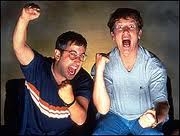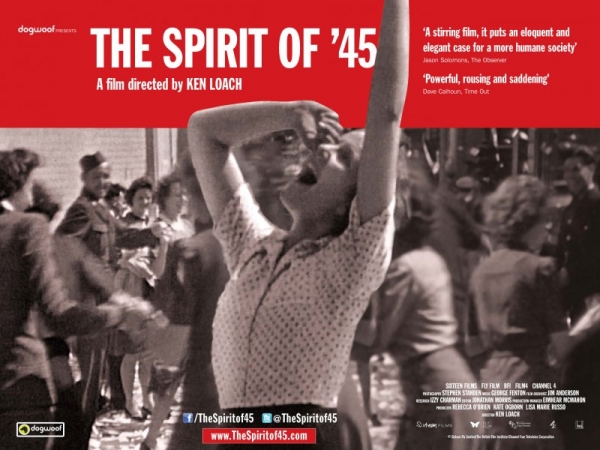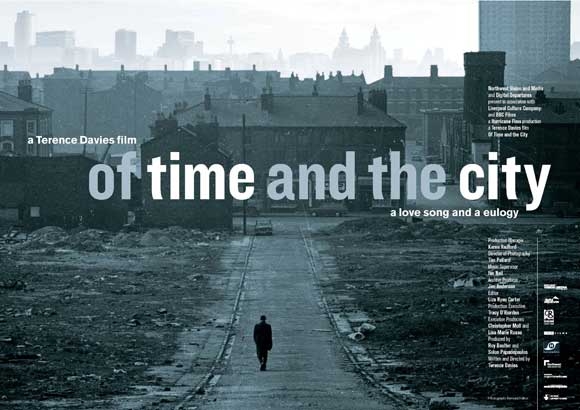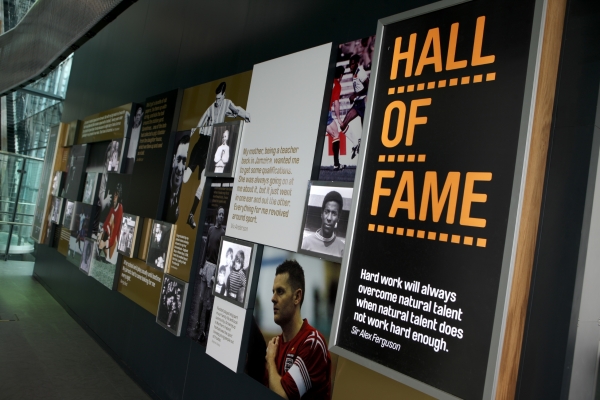Spirit of '45
Spirit of '45 is the new film from Ken Loach.
We interviewed member & the archive researcher on the film, Jim Anderson
What can you tell us about the film, The Spirit of ’45?
Firstly it’s a Ken Loach documentary mainly using post World War II archive film and TV intercut with interviews with expert witnesses from that era.
They eloquently and movingly tell us something of their life histories, what real life was like in the late 40’s and 50’s, how they coped and how things gradually changed and improved after the war especially in health and housing.
I’d suggest a visit to the website www.thespiritof45.com would be the best thing to do to find out more and where it is being screened in March. Here’s the blurb:
1945 was a pivotal year in British history. The unity that carried Britain through the war allied to the bitter memories of the inter-war years led to a vision of a better society. The spirit of the age was to be our brother's and our sister's keeper. Ken has used film from Britain's regional and national archives, alongside sound recordings and contemporary interviews to create a rich political and social narrative. The Spirit of '45 hopes to illuminate and celebrate a period of unprecedented community spirit in the UK, the impact of which endured for many years and which may yet be rediscovered today.
What was your brief and what resources did you find most useful for this film?
My main brief to begin with in June 2010 was to find as much quality footage as possible depicting life in Britain during the 10 years after World War II ended.
Topics were discussed the main ones included:
Celebrations at the end of the war and coming home
People's hopes and aspirations
The idea of full employment and all classes working together
The Labour movement and new government
Industry/Mining/Railways and Nationalisation
Housing, Health and the new NHS
Also a little 1930's UK Life between wars
Ken especially wanted material that featured real people’s lives not the rich or famous.
The main sources were BBC, British Pathe, Movietone, Imperial War Museum, The BFI and ITN but there were many other archives which supplied useful material.
Can you describe your process of researching, from start to finish?
The work started in June 2010. Having decided on topics that Ken wanted to feature from experience I already know the most likely good archive sources and made contact with them and searched on their online catalogues. However at the beginning is the time to attempt to find ALL the relevant footage from as many sources as possible in the UK and abroad. This is done mainly by an email to the huge circle around the globe - sources that I am already aware of.
So after several weeks I had found or had been sent a huge amount of material some great, some good some not worth considering further. The next step is to get feedback from Ken on what he liked and disliked and see if he agreed with my thoughts on what was good or useless. The best of many many hours of footage was then watched by me and Ken together at his London production office. Only the more relevant was kept and this was stored for future editing. This feedback then guides where and how I look for more material.
By the beginning of Oct 2010 we had selected and saved about 5 or more hours of clips of good 1930 -1955 archive material - enough to make the majority of the film.
Then Ken and I went onto work on other projects.
Around Easter 2012 Ken started to film interviews for the film and in the summer editing began and just before that I was given a new brief mainly regarding more modern footage from the 1979 onwards but dealing with many of the same topics as before.
The edit was mostly completed by the autumn of 2012 when the processing of identifying, clearing and licencing all the material in the film began. This involves quite a lot of help from my production manager at Sixteen Films Eimhear McMahon and also the staff from our archive sources. After some negotiation about what we could afford to include for our limited documentary budget the film was nearly finished by December ready for the final post production work.
Other than time, what is the most valuable thing to help you do your job?
My memory and the one in the laptop where all the work gets done.
How did you get the job on Spirit of ’45 and can you describe your working relationship with Ken Loach?
Through Lisa Marie Russo, who I worked with on several films, most notably on “Of Time and The City”. In 2009 she set up a company with Kate Ogborn called Fly Films. They’ve been very successful and I’ve worked on several of their films including “The Deep Blue Sea” and “Self Made”.
Ken as you can imagine was great to work with giving me clear direction to my research and very quickly we identified the style of footage that was best for he film he wanted to make.
How did you begin in this line of work and end up working on feature films?
I suppose I stared almost 50 years ago watching Bill and Ben progressing onto Blue Peter, FA Cup finals and Top of the Pops.
 My big break came in 1992 when I started to work as an assistant producer for BBC2 on “Fantasy Football League” for Frank Skinner and David Baddiel where each week I raided the BBC archives for a huge array of clips for their topical gags and material featuring their guests such as Elvis Costello and Basil Brush. I then went on to work on the film Fever Pitch and having worked as a Location Director and AP (often finding useful archive material) I went on to produce and direct several programmes including series for ITV, The Discovery Channel and “The Premiership’s Greatest Foreign Footballers” for Sky One.
My big break came in 1992 when I started to work as an assistant producer for BBC2 on “Fantasy Football League” for Frank Skinner and David Baddiel where each week I raided the BBC archives for a huge array of clips for their topical gags and material featuring their guests such as Elvis Costello and Basil Brush. I then went on to work on the film Fever Pitch and having worked as a Location Director and AP (often finding useful archive material) I went on to produce and direct several programmes including series for ITV, The Discovery Channel and “The Premiership’s Greatest Foreign Footballers” for Sky One.
After years of working on factual entertainment and documentaries for TV luckily a colleague phoned me to tell me that a film directed by Terence Davies called “Of Time and the City” was to be produced in Liverpool.
You curated the archive at Football Museum in Manchester, can you tell us about that?
That was a huge job with well over 50 different exhibition areas and with probably 150 or more football clubs in England being represented in the museum. There were a number of hurdles to get over, it was challenging to get lots of sources and contributors to donate their archive material – the museum’s fantastic and well worth a visit especially as it’s free! It’s good to think that the archive I found will have a life in the museum for many years to come unlike many TV programmes that are shown for a week or perhaps a year or two.
What is your personal favourite archive in the Football Museum?
The 1970 World Cup in Mexico is a favourite of mine that and Manchester Utd winning the treble in 1999 in Barcelona.
I love some of the old stills of football crowd and of famous 1960s footballers like Denis Law and Jimmy Greaves.
What have you got coming up in 2013?
I’m working on a film called Camera Trap a drama-thriller about a natural history camera crew set in Siberia forest and also to two short films about Stephen Hawking work and Large Hadron Collider for a major science award ceremony “The Fundamental Physics Prize” in Geneva.
Jim Anderson is a member of thecallsheet.co.uk. Members can see his profile page here.
thecallsheet.co.uk is a members only network for professionals working in Film and TV in the UK. With over 2,000 members and a database of over 40,000 productions, people and companies, we make it easy to find the best in the industry.


